1987 MAZDA 626 battery
[x] Cancel search: batteryPage 1766 of 1865
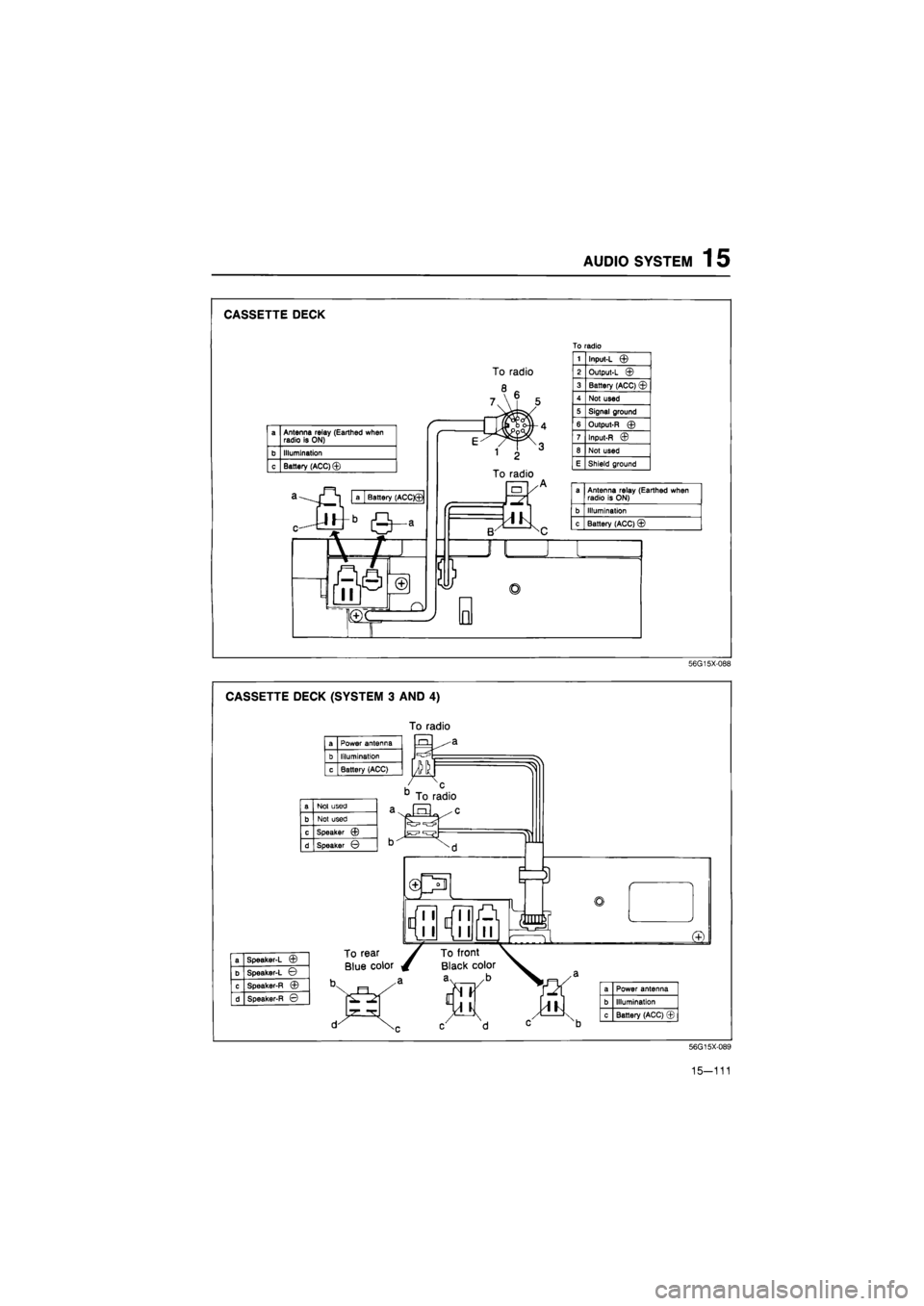
AUDIO SYSTEM 1 5
CASSETTE DECK
To radio
a Antenna relay (Earthed when radio is ON)
b Illumination
c Battery (ACC) ©
Battery (ACC)©
. • Q-
fi0
m
®
jqj
To radio
/
1 Input-L ©
2 Output-L ©
3 Battery (ACC) ©
4 Not used
5 Signal ground
6 Output-R ©
7 Input-R ©
8 Not used
E Shield ground
»
B /1 ^C
a Antenna relay (Earthed when radio is ON)
b Illumination
c Battery (ACC) ©
0
56G15X-088
CASSETTE DECK (SYSTEM 3 AND 4)
To radio
a Power antenna
b Illumination
c Battery (ACC) jm
a Not used
b Not used
c Speaker ©
d Speaker ©
To radio
JHL
a Speaker-L ©
b Speaker-L ©
c Speaker-R ©
d Speaker-R ©
To rear
Blue color
V m.
"T*.
a Power antenna
b Illumination
c Battery (ACC) ©
56G15X-089
15—111
Page 1767 of 1865
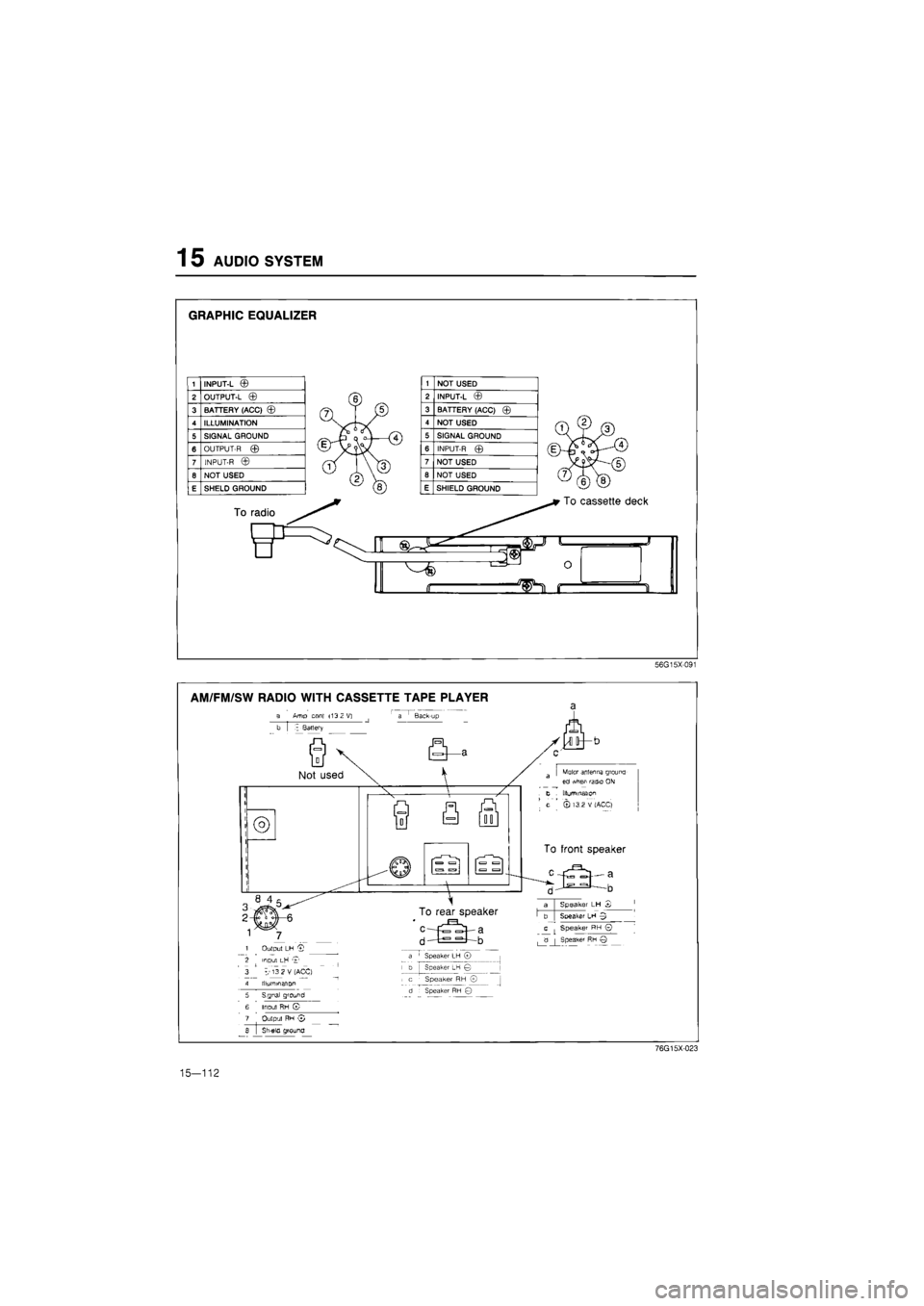
1 5 AUDIO SYSTEM
GRAPHIC EQUALIZER
1 INPUT-L ©
2 OUTPUT-L ©
3 BATTERY (ACC) ©
4 ILLUMINATION
5 SIGNAL GROUND
6 OUTPUT-R ©
7 INPUT-R ©
6 NOT USED
E SHELD GROUND
1 NOT USED
2 INPUT-L ©
3 BATTERY (ACC) ©
4 NOT USED
5 SIGNAL GROUND
6 INPUT-R ©
7 NOT USED
8 NOT USED
E SHIELD GROUND
To radio
6) (8)
To cassette deck
r
56G15X-091
AM/FM/SW RADIO WITH CASSETTE TAPE PLAYER
3 AfTtp coot
<13 2 VI
76G15X-023
15—112
Page 1788 of 1865
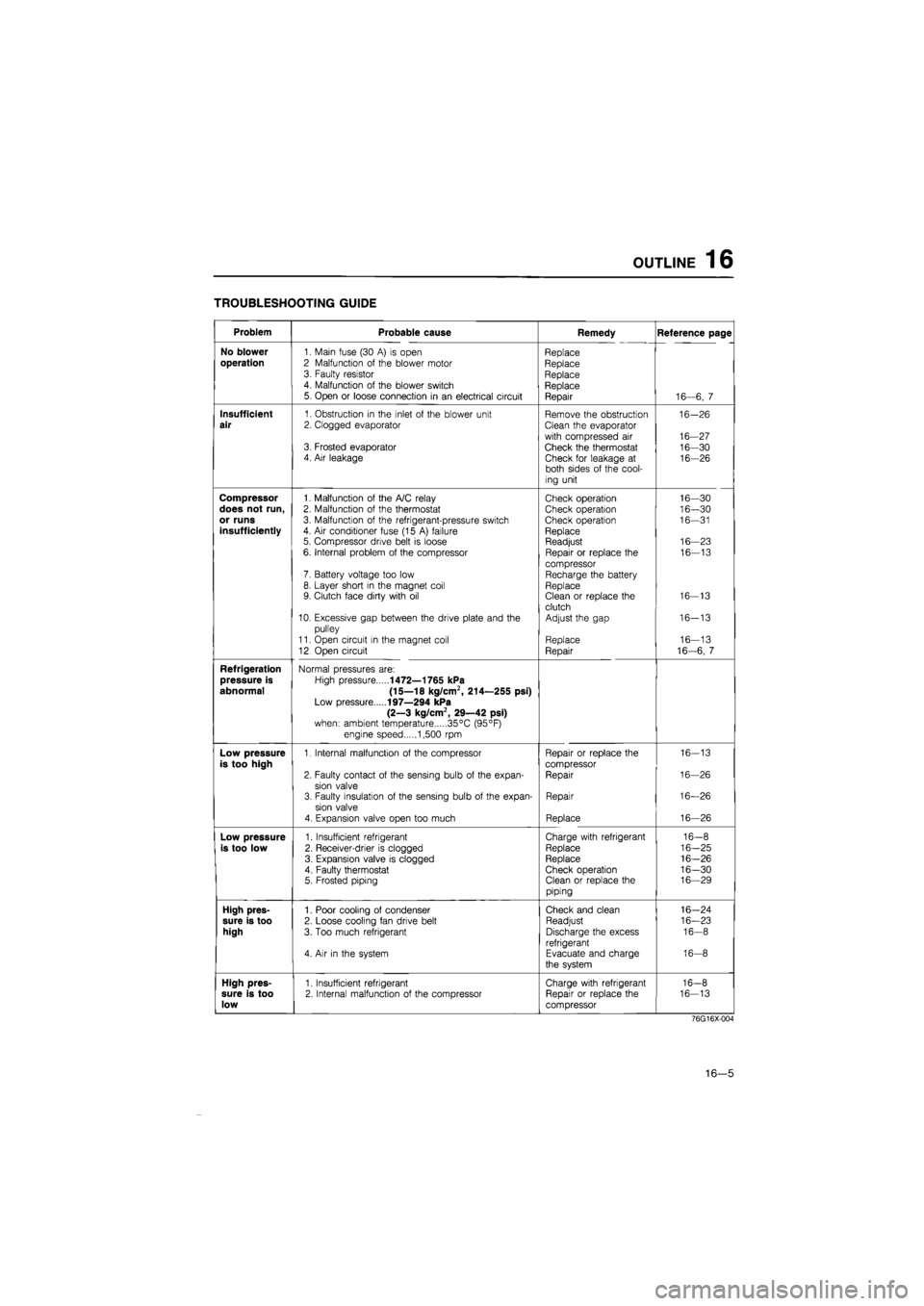
OUTLINE 16
TROUBLESHOOTING GUIDE
Problem Probable cause Remedy Reference page
No blower
1. Main fuse (30
A) is
open Replace
operation
2 Malfunction
of
the blower motor Replace 3. Faulty resistor Replace 4. Malfunction
of
the blower switch Replace 5. Open
or
loose connection
in an
electrical circuit Repair 16—6,
7
Insufficient
1. Obstruction
in
the inlet
of
the blower unit Remove the obstruction 16-26
air
2. Clogged evaporator Clean the evaporator
with compressed
air
16-27 3. Frosted evaporator Check the thermostat 16-30 4. Air leakage Check for leakage
at
16-26 both sides
of
the cool-
ing unit
Compressor
1. Malfunction
of
the A/C relay Check operation 16—30
does not run,
2. Malfunction
of
the thermostat Check operation 16—30
or runs
3. Malfunction
of
the refrigerant-pressure switch Check operation 16—31
insufficiently
4.
Air
conditioner fuse (15
A)
failure Replace 5. Compressor drive belt
is
loose Readjust 16—23
6. Internal problem
of
the compressor Repair
or
replace
the
16—13
compressor 7. Battery voltage too low Recharge the battery 8. Layer short
in
the magnet coil Replace 9. Clutch face dirty with
oil
Clean
or
replace the 16-13
clutch 10. Excessive gap between the drive plate and
the
Adjust the gap 16-13
pulley
11. Open circuit
in
the magnet coil Replace 16—13
12 Open circuit Repair 16-6,
7
Refrigeration
Normal pressures are:
pressure is
High pressure
1472—1765 kPa
abnormal (15—18 kg/cm2, 214—255 psi)
Low pressure
197—294 kPa
(2—3 kg/cm2, 29—42 psi)
when: ambient temperature 35°C (95°F)
engine speed 1,500
rpm
Low pressure
1. Internal malfunction
of
the compressor Repair
or
replace the 16-13
is too high
compressor
2. Faulty contact
of
the sensing bulb
of
the expan-Repair 16-26
sion valve 3. Faulty insulation
of
the sensing bulb
of
the expan-Repair 16—26
sion valve
4. Expansion valve open too much Replace 16—26
Low pressure
1. Insufficient refrigerant Charge with refrigerant 16-8
is too low
2. Receiver-drier
is
clogged Replace 16-25
3. Expansion valve
is
clogged Replace 16-26
4. Faulty thermostat Check operation 16-30 5. Frosted piping Clean
or
replace the 16—29
piping
High pres-
1. Poor cooling
of
condenser Check and clean 16-24
sure is too
2. Loose cooling fan drive belt Readjust 16—23
high
3. Too much refrigerant Discharge the excess 16-8
refrigerant 4.
Air in
the system Evacuate and charge 16-8
the system
High pres-
1. Insufficient refrigerant Charge with refrigerant 16-8
sure is too
2. Internal malfunction
of
the compressor Repair
or
replace the 16-13
low
compressor
76G16X-004
16—5
Page 1796 of 1865
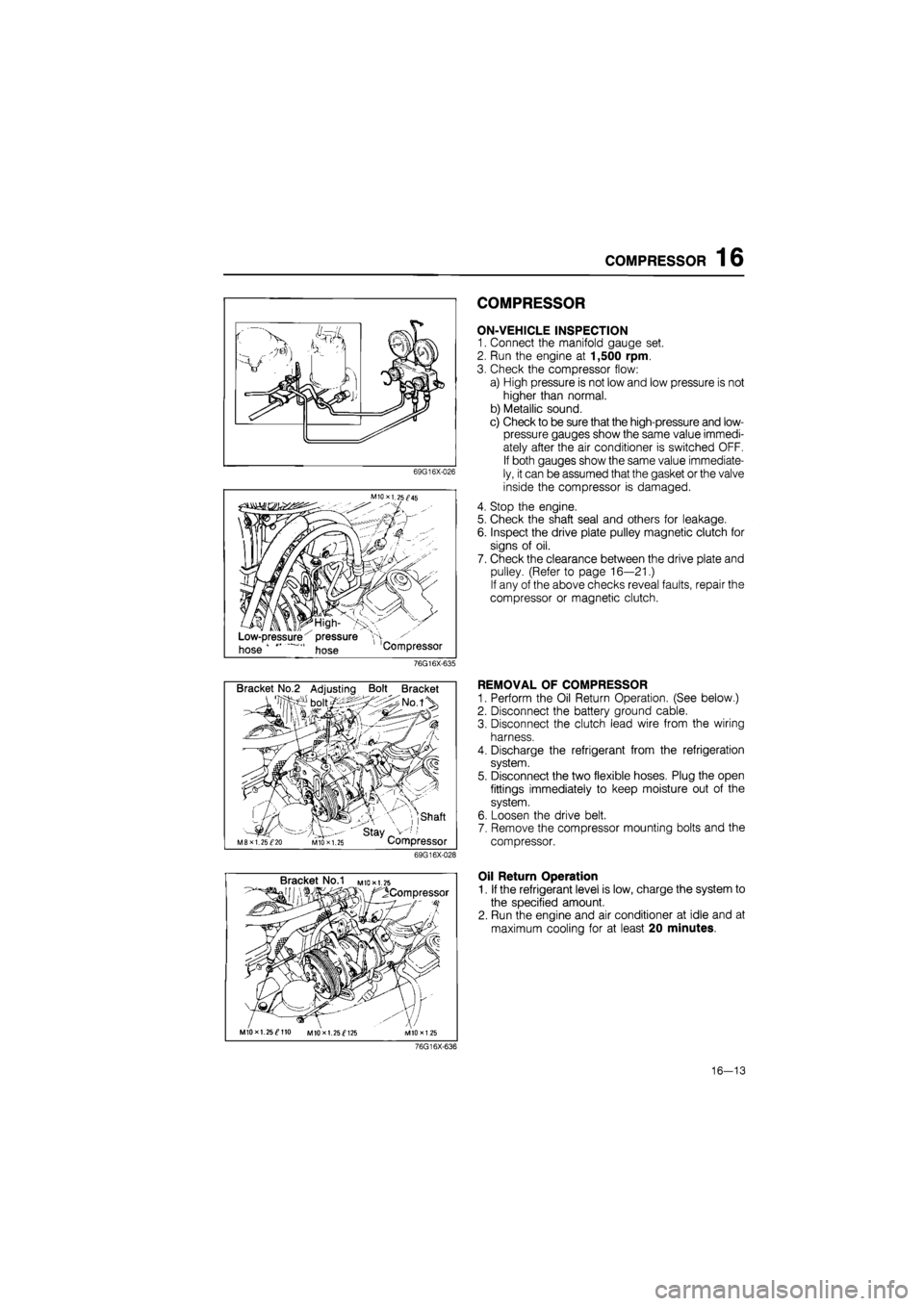
COMPRESSOR 16
69G16X-026
M10X1.25^45
Low-pressure x pressure
hose hose Compressor
COMPRESSOR
ON-VEHICLE INSPECTION
1. Connect the manifold gauge set.
2. Run the engine at 1,500 rpm.
3. Check the compressor flow:
a) High pressure is not low and low pressure is not
higher than normal.
b) Metallic sound.
c) Check to be sure that the high-pressure and low-
pressure gauges show the same value immedi-
ately after the air conditioner is switched OFF.
If both gauges show the same value immediate-
ly, it can be assumed that the gasket or the valve
inside the compressor is damaged.
4. Stop the engine.
5. Check the shaft seal and others for leakage.
6. Inspect the drive plate pulley magnetic clutch for
signs of oil.
7. Check the clearance between the drive plate and
pulley. (Refer to page 16—21.)
If any of the above checks reveal faults, repair the
compressor or magnetic clutch.
76G16X-635
Bracket No.2 Adjusting Bolt Bracket
, ,shaft
' stay _ M8XI. 25^20 MIO X 1.25 Compressor
69G16X-028
REMOVAL OF COMPRESSOR
1. Perform the Oil Return Operation. (See below.)
2. Disconnect the battery ground cable.
3. Disconnect the clutch lead wire from the wiring
harness.
4. Discharge the refrigerant from the refrigeration
system.
5. Disconnect the two flexible hoses. Plug the open
fittings immediately to keep moisture out of the
system.
6. Loosen the drive belt.
7. Remove the compressor mounting bolts and the
compressor.
Bracket No.1 M
to* 1.25
^Compressor
MIOxl. 25^110 MIOxl. 25^125
Oil Return Operation
1. If the refrigerant level is low, charge the system to
the specified amount.
2. Run the engine and air conditioner at idle and at
maximum cooling for at least 20 minutes.
76G16X-636
16—13
Page 1809 of 1865
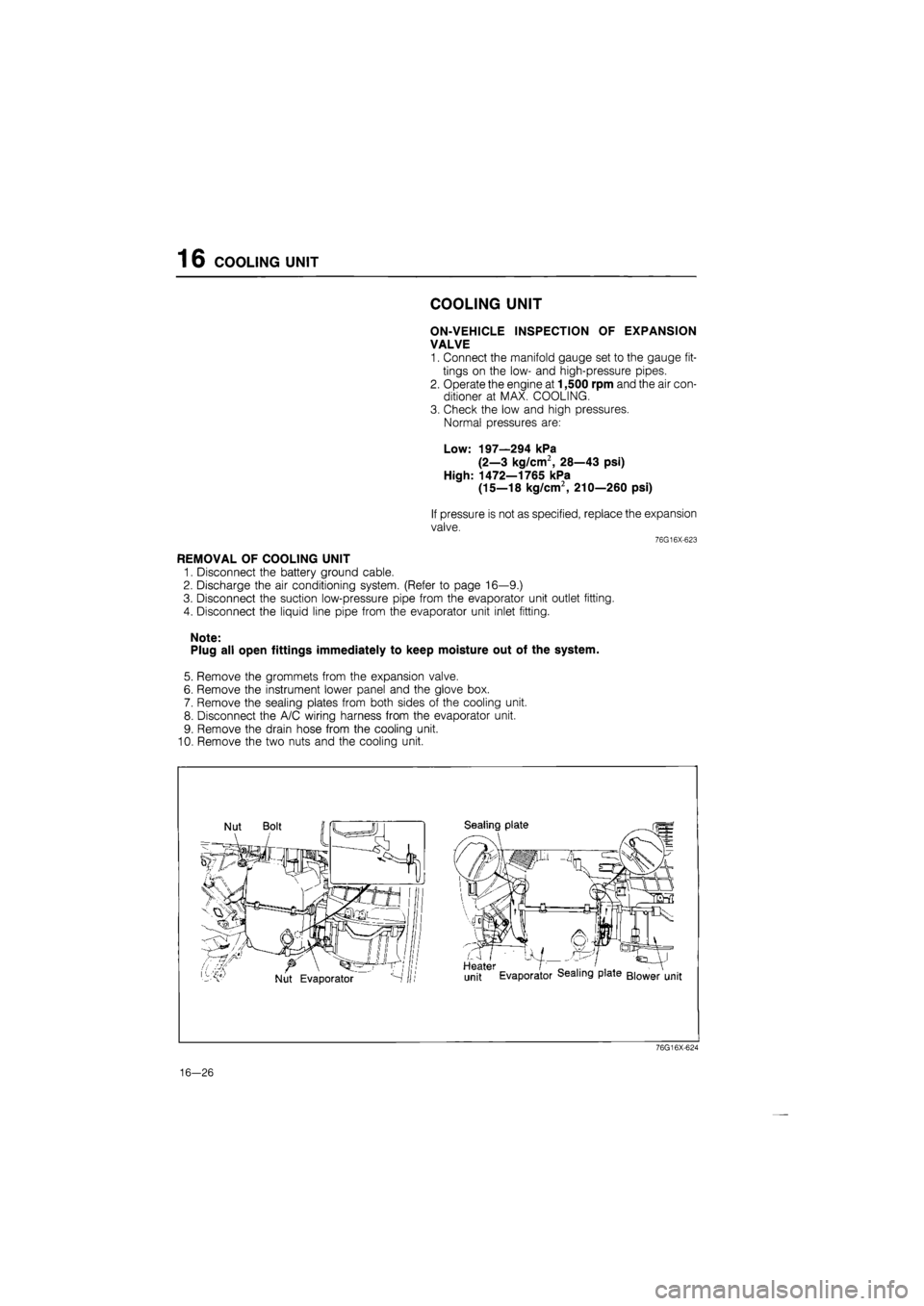
16 COOLING UNIT
COOLING UNIT
ON-VEHICLE INSPECTION OF EXPANSION
VALVE
1. Connect the manifold gauge set to the gauge fit-
tings on the low- and high-pressure pipes.
2. Operate the engine at 1,500 rpm and the air con-
ditioner at MAX. COOLING.
3. Check the low and high pressures.
Normal pressures are:
Low: 197—294 kPa
(2—3 kg/cm2, 28—43 psi)
High: 1472—1765 kPa
(15—18 kg/cm2, 210—260 psi)
If pressure is not as specified, replace the expansion
valve.
76G16X-623
REMOVAL OF COOLING UNIT
1. Disconnect the battery ground cable.
2. Discharge the air conditioning system. (Refer to page 16—9.)
3. Disconnect the suction low-pressure pipe from the evaporator unit outlet fitting.
4. Disconnect the liquid line pipe from the evaporator unit inlet fitting.
Note:
Plug all open fittings immediately to keep moisture out of the system.
5. Remove the grommets from the expansion valve.
6. Remove the instrument lower panel and the glove box.
7. Remove the sealing plates from both sides of the cooling unit.
8. Disconnect the A/C wiring harness from the evaporator unit.
9. Remove the drain hose from the cooling unit.
10. Remove the two nuts and the cooling unit.
76G16X-624
16-26
Page 1813 of 1865
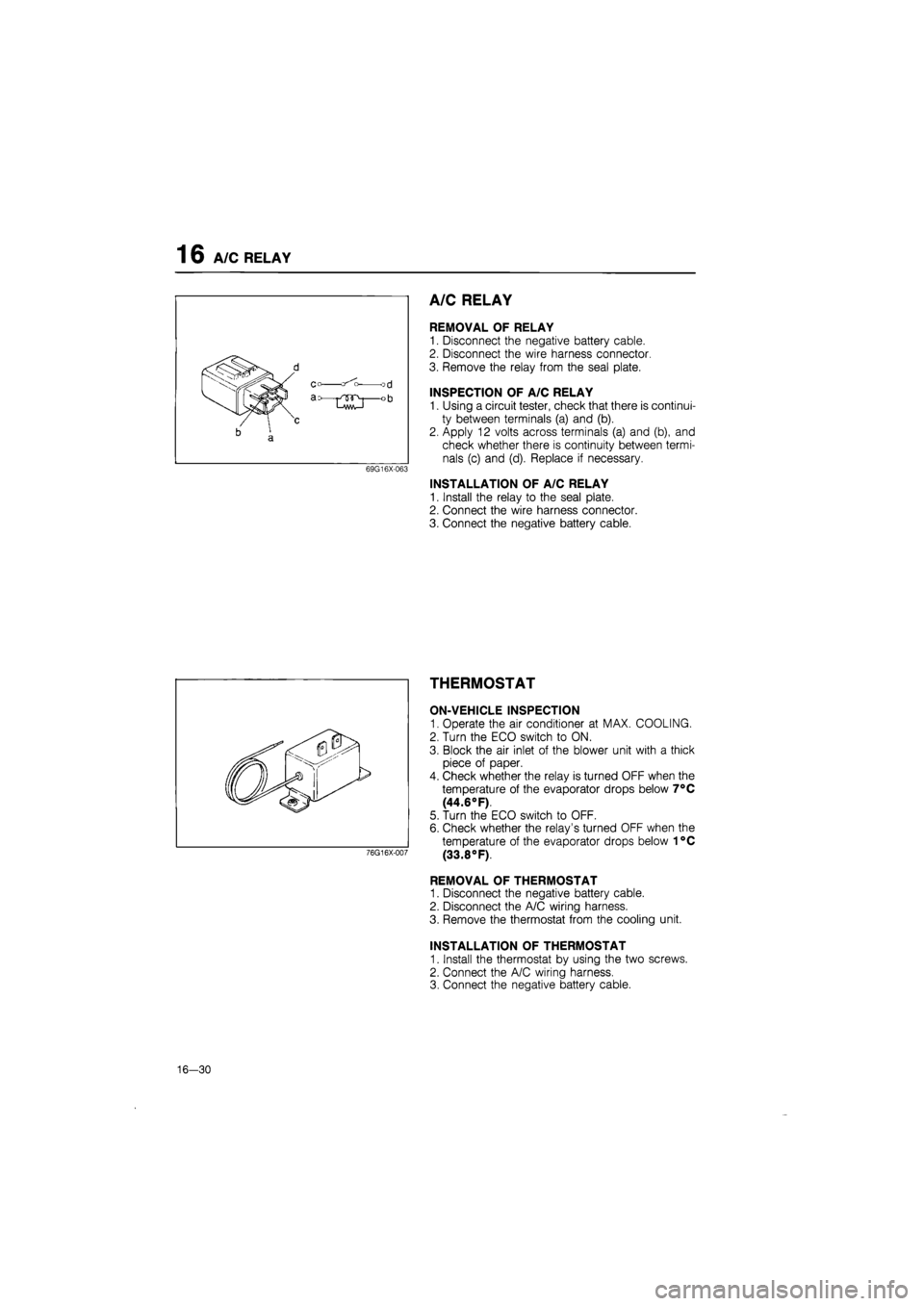
1 6 A/C RELAY
A/C RELAY
REMOVAL OF RELAY
1. Disconnect the negative battery cable.
2. Disconnect the wire harness connector
3. Remove the relay from the seal plate.
INSPECTION OF A/C RELAY
1. Using a circuit tester, check that there is continui-
ty between terminals (a) and (b).
2. Apply 12 volts across terminals (a) and (b), and
check whether there is continuity between termi-
nals (c) and (d). Replace if necessary.
INSTALLATION OF A/C RELAY
1. Install the relay to the seal plate.
2. Connect the wire harness connector.
3. Connect the negative battery cable.
THERMOSTAT
ON-VEHICLE INSPECTION
1. Operate the air conditioner at MAX. COOLING.
2. Turn the ECO switch to ON.
3. Block the air inlet of the blower unit with a thick
piece of paper.
4. Check whether the relay is turned OFF when the
temperature of the evaporator drops below 7°C
(44.6°F).
5. Turn the ECO switch to OFF.
6. Check whether the relay's turned OFF when the
temperature of the evaporator drops below 1°C
(33.8°F).
REMOVAL OF THERMOSTAT
1. Disconnect the negative battery cable.
2. Disconnect the A/C wiring harness.
3. Remove the thermostat from the cooling unit.
INSTALLATION OF THERMOSTAT
1. Install the thermostat by using the two screws.
2. Connect the A/C wiring harness.
3. Connect the negative battery cable.
76G16X-007
16-30
Page 1837 of 1865
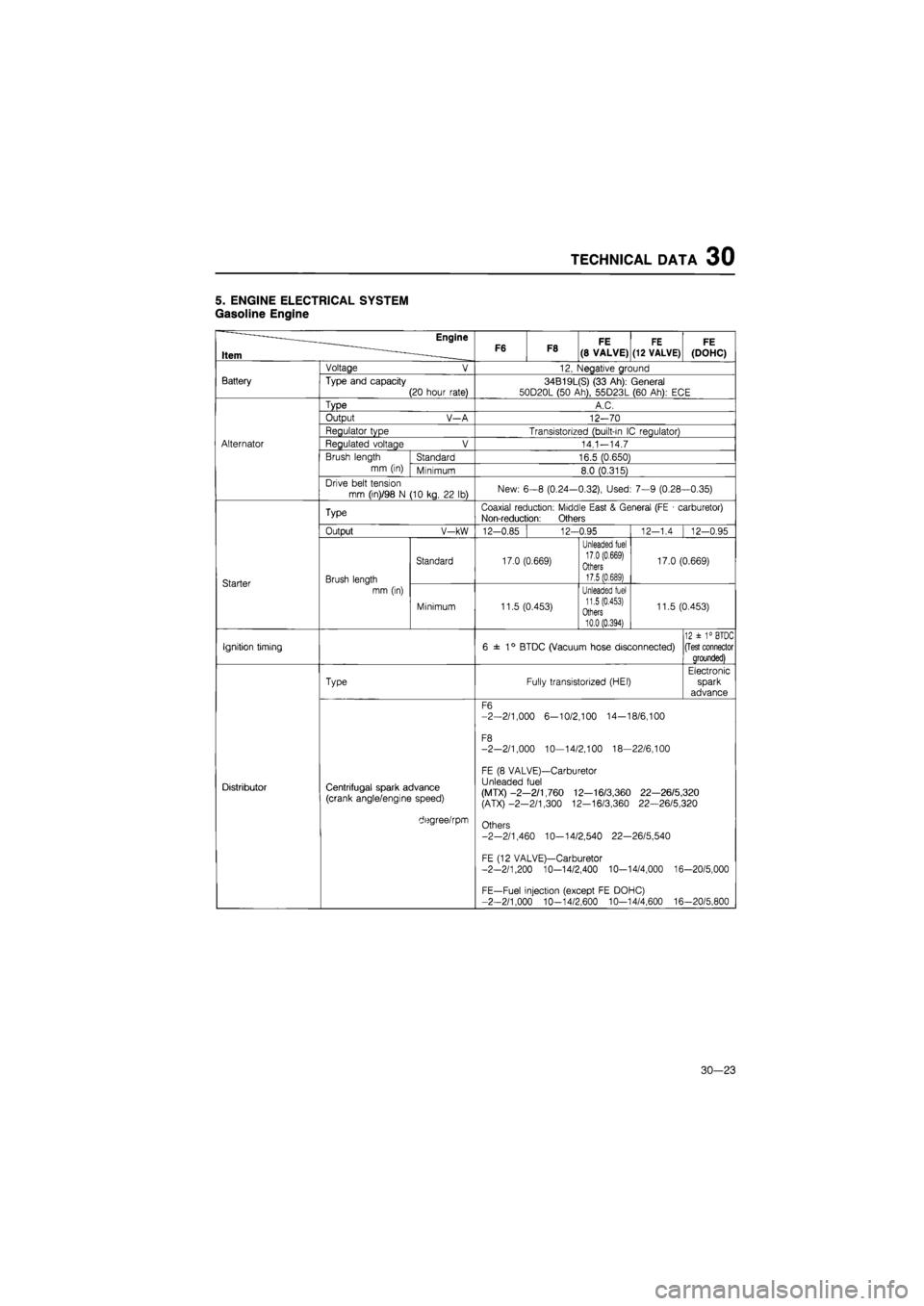
TECHNICAL DATA 30
5. ENGINE ELECTRICAL SYSTEM
Gasoline Engine
——— Engine
F6 F8 FE FE FE
Item ____ F6 F8 (8 VALVE) (12 VALVE) (DOHC)
Battery
Voltage
Type and capacity
12, Negative ground
(20 hour rate) 34B19L(S) (33 Ah): General 50D20L (50 Ah), 55D23L (60 Ah):
ECE
Alternator
Type A.C.
Output V-A 12-70
Regulator type Transistorized (built-in
IC
regulator)
Regulated voltage 14.1-14.7
Brush length
mm (in) Standard 16.5 (0.650)
Minimum 8.0 (0.315)
Drive belt tension
mm (in)/98
N (10
kg,
22 lb)
New:
6-8
(0.24-0.32), Used:
7-9
(0.28—0.35)
Starter
Type Coaxial reduction: Middle East
&
General (FE
•
carburetor)
Non-reduction: Others
Output V-kW 12-0.85
Brush length mm (in)
12-0.95
Standard 17.0 (0.669)
Minimum 11.5 (0.453)
Unleaded fuel
17,0 (0.669)
Others
17.5 (0.689)
Unleaded fuel
11.5 (0.453)
Others
10.0 (0.394)
12-1.4 12-0.95
17.0 (0.669)
11.5 (0.453)
Ignition timing 6
±
1
°
BTDC (Vacuum hose disconnected) 12
±
1° BTDC
(Test connector
grounded)
Distributor
Type Fully transistorized (HEI)
Electronic spark advance
Centrifugal spark advance
(crank angle/engine speed)
degree/rpm
F6
-2-2/1,000 6-10/2,100 14-18/6,100
F8 -2-2/1,000 10—14/2,100 18-22/6,100
FE
(8
VALVE)—Carburetor Unleaded fuel
(MTX)-2—2/1,760 12—16/3,360 22—26/5,320 (ATX)-2-2/1,300 12-16/3,360 22-26/5,320
Others
-2-2/1,460 10-14/2,540 22-26/5,540
FE (12 VALVE)—Carburetor -2-2/1,200 10-14/2,400 10-14/4,000 16-20/5,000
FE—Fuel injection (except
FE
DOHC)
-2-2/1,000 10-14/2,600 10-14/4,600 16-20/5,800
30—23